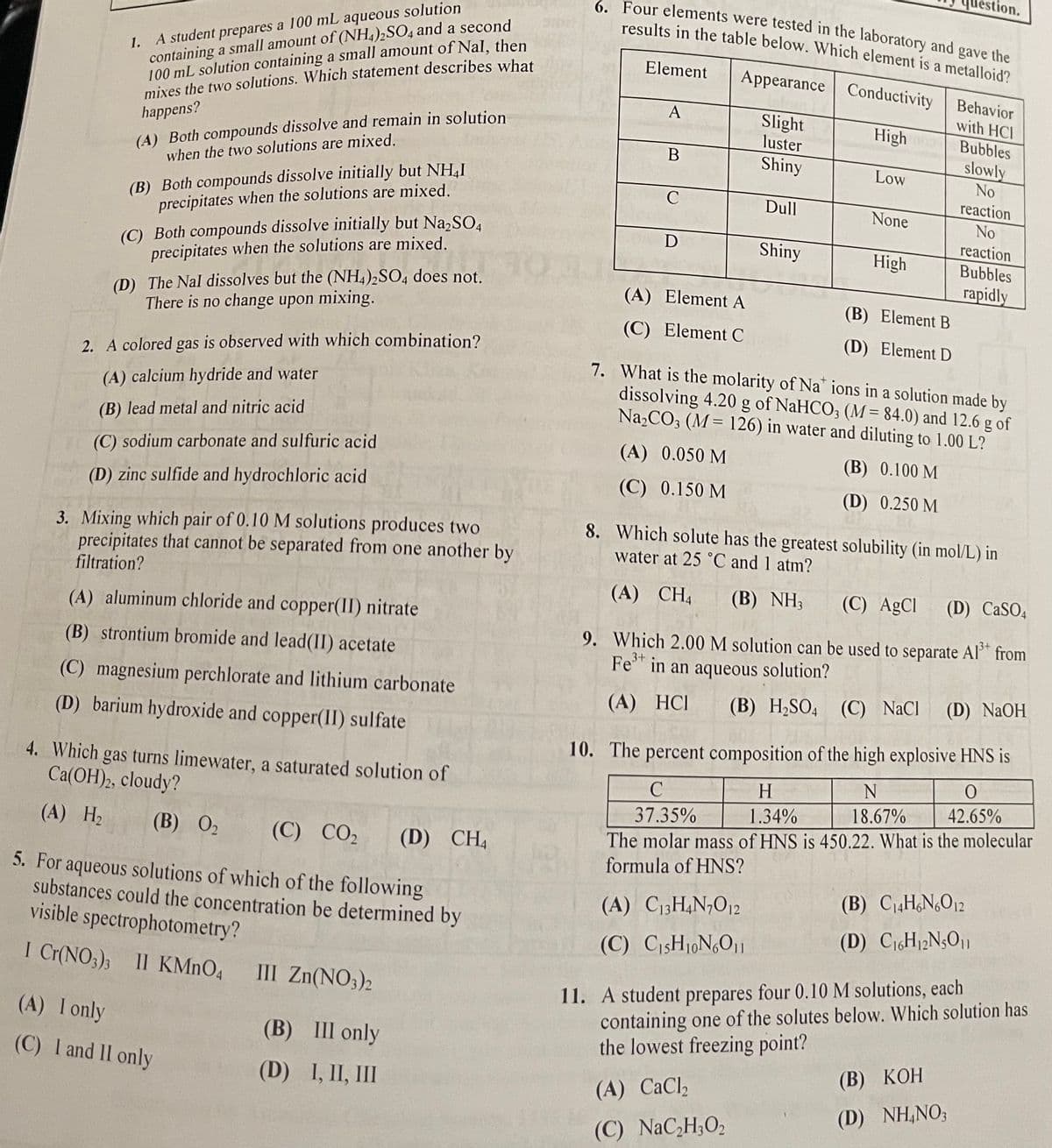1. A student prepares a 100 mL aq containing a small amount of (NH4)2SO4 and a second 100 mL solution containing a small amount of Nal, then mixes the two solutions. Which statement describes what happens? (A) Both compounds dissolve and remain in solution when the two solutions are mixed. (B) Both compounds dissolve initially but NHI precipitates when the solutions are mixed. (C) Both compounds dissolve initially but Na₂SO4 precipitates when the solutions are mixed. (D) The Nal dissolves but the (NH4)2SO4 does not. There is no change upon mixing.
1. A student prepares a 100 mL aq containing a small amount of (NH4)2SO4 and a second 100 mL solution containing a small amount of Nal, then mixes the two solutions. Which statement describes what happens? (A) Both compounds dissolve and remain in solution when the two solutions are mixed. (B) Both compounds dissolve initially but NHI precipitates when the solutions are mixed. (C) Both compounds dissolve initially but Na₂SO4 precipitates when the solutions are mixed. (D) The Nal dissolves but the (NH4)2SO4 does not. There is no change upon mixing.
Chemistry
10th Edition
ISBN:9781305957404
Author:Steven S. Zumdahl, Susan A. Zumdahl, Donald J. DeCoste
Publisher:Steven S. Zumdahl, Susan A. Zumdahl, Donald J. DeCoste
Chapter4: Types Of Chemical Reactions And Solution Stoichiometry
Section: Chapter Questions
Problem 47E
Related questions
Question
I need help with these questions?

Transcribed Image Text:1. A student prepares a 100 mL aqueous solution
containing a small amount of (NH4)2SO4 and a second
100 mL solution containing a small amount of Nal, then
mixes the two solutions. Which statement describes what
happens?
(A) Both compounds dissolve and remain in solution
when the two solutions are mixed.
(B) Both compounds dissolve initially but NHI
precipitates when the solutions are mixed.
(C) Both compounds dissolve initially but Na₂SO4
precipitates when the solutions are mixed.
(D) The Nal dissolves but the (NH4)2SO4 does not.
There is no change upon mixing.
2. A colored gas is observed with which combination?
(A) calcium hydride and water
(B) lead metal and nitric acid
(C) sodium carbonate and sulfuric acid
(D) zinc sulfide and hydrochloric acid
3. Mixing which pair of 0.10 M solutions produces two
precipitates that cannot be separated from one another by
filtration?
(A) aluminum chloride and copper(II) nitrate
(B) strontium bromide and lead(II) acetate
(C) magnesium perchlorate and lithium carbonate
(D) barium hydroxide and copper(II) sulfate
4. Which gas turns limewater, a saturated solution of
Ca(OH)2, cloudy?
(A) H₂ (B) 0₂
(C) CO₂ (D) CH4
5. For aqueous solutions of which of the following
substances could the concentration be determined by
visible spectrophotometry?
I Cr(NO3)3 II KMnO4
(A) I only
(C) I and II only
101
III Zn(NO3)2
(B) III only
(D) I, II, III
6. Four elements were tested in the laboratory and gave the
results in the table below. Which element is a metalloid?
Element
Appearance
Conductivity
High
A
B
C
D
(A) Element A
(C) Element C
(A) 0.050 M
(C) 0.150 M
Slight
luster
Shiny
Dull
Shiny
Low
(A) C₁3H4N7O12
(C) C₁5H10N6O11
None
High
(B) Element B
(D) Element D
7. What is the molarity of Nations in a solution made by
dissolving 4.20 g of NaHCO3 (M = 84.0) and 12.6 g of
Na₂CO3 (M= 126) in water and diluting to 1.00 L?
(B)
0.100 M
(D) 0.250 M
stion.
Behavior
with HCI
Bubbles
slowly
No
reaction
No
reaction
Bubbles
rapidly
8. Which solute has the greatest solubility (in mol/L) in
water at 25 °C and 1 atm?
(A) CH4 (B) NH,
(C) AgCl (D) CaSO4
9. Which 2.00 M solution can be used to separate Al³+ from
Fe³+ in an aqueous solution?
3+
(A) HCI
(B) H₂SO4 (C) NaCl (D) NaOH
10. The percent composition of the high explosive HNS is
C
H
N
0
37.35% 1.34% 18.67% 42.65%
The molar mass of HNS is 450.22. What is the molecular
formula of HNS?
(B) C₁4H6N6012
(D) C₁6H₁2N5O11
(B) KOH
(D) NH4NO3
11. A student prepares four 0.10 M solutions, each
containing one of the solutes below. Which solution has
the lowest freezing point?
(A) CaCl₂
(C) NaC₂H₂O₂
Expert Solution
This question has been solved!
Explore an expertly crafted, step-by-step solution for a thorough understanding of key concepts.
This is a popular solution!
Trending now
This is a popular solution!
Step by step
Solved in 3 steps

Knowledge Booster
Learn more about
Need a deep-dive on the concept behind this application? Look no further. Learn more about this topic, chemistry and related others by exploring similar questions and additional content below.Recommended textbooks for you

Chemistry
Chemistry
ISBN:
9781305957404
Author:
Steven S. Zumdahl, Susan A. Zumdahl, Donald J. DeCoste
Publisher:
Cengage Learning

Chemistry: An Atoms First Approach
Chemistry
ISBN:
9781305079243
Author:
Steven S. Zumdahl, Susan A. Zumdahl
Publisher:
Cengage Learning


Chemistry
Chemistry
ISBN:
9781305957404
Author:
Steven S. Zumdahl, Susan A. Zumdahl, Donald J. DeCoste
Publisher:
Cengage Learning

Chemistry: An Atoms First Approach
Chemistry
ISBN:
9781305079243
Author:
Steven S. Zumdahl, Susan A. Zumdahl
Publisher:
Cengage Learning


Chemistry for Today: General, Organic, and Bioche…
Chemistry
ISBN:
9781305960060
Author:
Spencer L. Seager, Michael R. Slabaugh, Maren S. Hansen
Publisher:
Cengage Learning

General Chemistry - Standalone book (MindTap Cour…
Chemistry
ISBN:
9781305580343
Author:
Steven D. Gammon, Ebbing, Darrell Ebbing, Steven D., Darrell; Gammon, Darrell Ebbing; Steven D. Gammon, Darrell D.; Gammon, Ebbing; Steven D. Gammon; Darrell
Publisher:
Cengage Learning

Chemistry: Principles and Practice
Chemistry
ISBN:
9780534420123
Author:
Daniel L. Reger, Scott R. Goode, David W. Ball, Edward Mercer
Publisher:
Cengage Learning